Welcome to The Doppelganger Files! My goal with this column is to examine various films that have been remade/rebooted/readdressed over the years with the intention of playing something of a compare and contrast game with them. I get just as pissed as anyone else at the multitude of rehashes that Hollywood is content to throw out into the aether in the absence of original stories, but if we’re being honest, they’re not all bad. Some of them are actually pretty good. And even the films that don’t live up to the legacy set forth by their predecessors aren’t always a complete and total loss. New scenes, different takes on classic characters, additions to mythology can make the remakes an interesting addition to the landscape. My goal is not to sit here and try to convince you that all the remakes are inherently better/preferable to the films that inspired them. Rather, to examine a pair of films and see what they did differently, and what worked - on both sides
So to kick this all off, I thought it would be fun to reminisce about a classic film that probably played a formative experience everyone’s life (at least it did in mine) - The Wizard of Oz. It also seemed doubly-appropriate since the film just did its IMAX 3D run, and just had a new Blu-ray re-release.

Victor Fleming’s 1939 classic was a staple film of my childhood. I watched it constantly. I adored it. It was one of the first fantasies that I truly found myself swept up in. Pure magic - the tornado, the wicked witch, the colorful cast of characters, the music, the change from black and white to vivid color - The Wizard of Oz was movie magic and childhood fantasy at its absolute best. I remember hiding behind our couch whenever Miss Gulch entered the scene on her bicycle (strangely, I was more afraid of her than I was of the witch). I sang along with the songs, cheered when Dorothy finally triumphed over the Wicked Witch of the West and felt so relieved when she was finally safe at home in Kansas again.
Doubtless, many of you had similar experiences with this film when you were kids. It’s become both a classic film and required viewing before preschool even starts. It’s impossible to imagine this beloved story in any variation other than the one directed by Victor Fleming. Judy Garland, “Over the Rainbow”, Frank Morgan as the Wizard, the incredible Margaret Hamilton and the presence that she brought to the Wicked Witch of the West, the Ruby Slippers - these are all pieces that have made Fleming’s film the quintessential adaptation of Baum’s story, as well a classic piece of cinema.
But this film was not the first adaptation of The Wonderful Wizard of Oz to hit the big screen. Dorothy and her friends went through multiple incarnations before MGM got a hold of the property in the ‘30s and created the masterpiece we all know and love. Here’s a bit of a history lesson on the property:
L. Frank Baum published The Wonderful Wizard of Oz in 1900. It was immediately a critical and financial success and was adored by fans everywhere. He went on to write 13 additional Oz books (as well as numerous other titles). The Oz legacy was continued after his death, with about a billion other volumes being written by numerous authors, most notably Ruth Plumly Thompson and Roger S. Baum, the great-grandson of the original author.
1902 saw the first incarnation of Dorothy and Oz developed off the written page. Baum worked with composer Paul Tietjens and director Julian Mitchell on a stage musical based on the book. It deviated from the original story quite a bit though (Toto was replaced by Imogen the cow, while the Wicked Witch was eliminated completely), and seemed to be geared more toward adults.
After the stage production, The Wonderful Wizard of Oz property went through several film adaptations (several of the other books were turned into films as well in the early days, some of which Baum was involved with himself). The first came about in 1910 and was a silent short that seems to have incorporated aspects from the stage musical and ran only 15 minutes.
The second version, and the one I chose to focus on today, was filmed in 1925 (after Baum’s death), and was also a silent film, but was feature-length at a runtime of 93 minutes. It was directed and co-adapted by comedian Larry Semon, who also starred in the film. Leon Lee and L. Frank Baum Jr. also share writing credits, with Baum serving as producer as well. Despite having Baum’s son on board the project, this version is actually quite a departure from the original source material, and very different from the film that would win the hearts of audiences 15 years later.
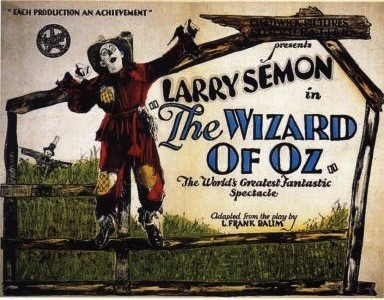
A quick plot synopsis:
The story opens in Oz, in the court of the evil Prime Minister Kruel (Josef Swickard). He has led the country (to the apparent despair of the people) since the future queen, Dorothea (Dorothy Dwan), was mysteriously taken from her crib years ago and (unbeknownst to her people) was left on a farm in Kansas. With her was left a letter declaring her birthright, and instructions that this letter should be read by her, and only her, when she reaches her 18th birthday.
The people of Oz seem to be rather fed up with Kruel’s bullshit, and, led by Prince Kynd (Bryant Washburn), demand that the princess be returned so that she may be crowned. Kruel sends his croney Ambassador Wikked (Otto Lederer) and his lackeys to Kansas to obtain and destroy the letter confirming Dorothy’s identity, so that she can never ascend to the throne.
The tone of this film is completely different from what we would come to associate with anything relating to Oz, with this one being more of a comedic, slapsticky romp and having little at all to do with fantasy or magic. Most of the first 45 minutes or so are spent on Uncle Henry’s (Frank Alexander) farm in Kansas, where he spends his time yelling at Dorothy for no apparent reason, and abusing the farmhands. The farmhands, are another departure from the source material, as they are the focal point of our story - not Dorothy. The main characters (who are not given names) are played by Larry Semon and Oliver Hardy. There is also a third farmhand, named Snowball, played by African-American actor Spencer Bell, in the first of several bouts of good-old-fashioned-early-20th-century-racism. And let’s be clear, while I’m on the racism subject - it’s not as if 1939 Oz was the pinnacle of diversity, but the racial elements on display here are just embarrassing.
Anyway, most of the time spent on the farm in Kansas is devoted to what I can only call “farm shenanigans.” Semon and Hardy are in competition with one another for Dorothy’s affections (though, she never decidedly states which one she prefers), entering into one comedic scenario after another, with pissy old Uncle Henry thrown into the mix for good measure.There are egg gags, a bee attack, sitting on cactus plants, characters being catapulted through the air - one cartoony vaudevillian scene after another.
Eventually, Wikked and his posse arrive (via airplane, and dressed like bandits) to reclaim the papers that arrived with Dorothy the night she was found. In a dastardly move, they capture Dorothy and suspend her from the top of the farm’s water tower. In a move to make themselves even more dastardly, they set a fire under the rope and wait for it to burn through, which will send Dorothy plummeting to her death. Semon manages to catch her (or rather, to allow her to land on him), breaking her fall and saving her life.
Suddenly, a storm comes out of nowhere, and the farmhands, Uncle Henry and Dorothy find refuge inside the barn. Before long, the barn is lifted off the ground and is rolled over a cliff by the tornado, smashing on the ground below, which conveniently happens to be Oz.
Prime Minister Kruel and his guards are quickly on the scene. The farmhands flee, with Semon hiding in a nearby cornfield and Hardy taking refuge in a huge pile of junk. They adopt disguises (Semon dismantling a scarecrow and putting on its clothes and Hardy putting on enough bits of junk to become a tin man), and Kruel’s wizard (who we learn is little more than a showman) claims to have done it all through magic. These scenes, of course, are accompanied by more comedic antics.
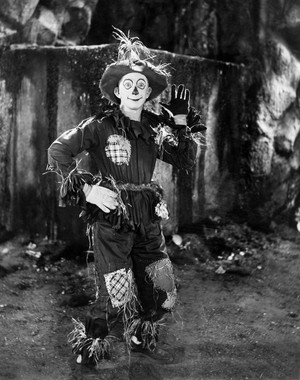
It doesn’t take terribly long for Kruel to figure out the ruse, and eventually, the farmhands are arrested and brought to trial. In order to cover his own ass, Kruel maintains that the farmhands are responsible for Dorothy’s kidnapping. Hardy betrays the others, pinning the whole thing on them in an effort to get himself out of trouble. It works, and he is knighted for his deeds and Semon and Snowball are sentenced to the dungeon. Dorothy is made Queen, but Kruel declares that he will continue to rule as Dictator (I know, I don’t get it either. I also don’t really understand how Prince Kynd plays into any of this).
More comedic antics ensue with Semon and Snowball in the dungeon. Like all good dungeons, this one is equipped with lions. Snowball dresses up in a lion costume and scares the guards away so the two can make their escape. They are pursued by the guards (led by Hardy) and what follows is a prolonged hide-and-seek-style chase sequence.
Kruel takes the opportunity to make his (kind of rapey) move on Dorothy in an attempt to marry her and secure his position of power. He is interrupted by Prince Kynd, and the two dual. It’s not looking good for the prince, but Semon shows up and drops a vase onto Kruel’s head from the balcony above. Kruel is taken to the dungeon. Semon, hoping to have finally won Dorothy’s affections, discovers that she has fallen in love with Prince Kynd.
But it’s not over. Wikked’s men continue to chase Semon, and as he climbs a nearby tower to escape, they take aim at him with a cannon. At the last second, an airplane (piloted by Snowball) flies overhead, and Semon is able to grab onto the ladder and escape. The ladder breaks, however, and he falls to the ground, and Prince Kynd and Princess Dorothea live happily ever after.
Sorry - I wanted to make that shorter, but since I figured that, like me, most of you probably haven’t been exposed to this version of the story yet, and the details seemed important. If you want to check out the film in it’s entirety, here it is in full public domain glory.
So it goes without saying that this was definitely not The Wizard of Oz any of us grew up with. Not really in the slightest. And for a lot of reasons. One being the fact that there was a world of difference between the state of filmmaking in 1925 and and in 1939. The technology improved, and thus, directors were able to do new and exciting things with it. Sound was incorporated into film, for one thing. Cinematography and editing had improved, so while Semon managed to include some interesting shots into his film, it was nothing compared to the method of storytelling that Fleming was able to employ 15 years later. The medium was simply more advanced. Not to mention the addition of color photography, which Fleming was not only able to use in his film, but incorporate at a pivotal juncture in the story in order to make the transition to Oz even more exciting for his audience, as Dorothy leaves her new-located farmhouse and ventures into the unknown.
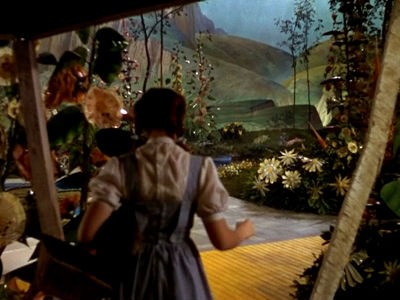
Another interesting variation in Semon’s film was in the characterizations - particularly in the character of Dorothy. She was the main focal point in Baum’s story, a element that was brought along to the 1939 film with Judy Garland playing (and owning) the role. Garland, as Dorothy, must navigate the strange land of Oz and the dangers set forth by the Wicked Witch of the West. Sure, she has the support of the friends that she makes along the way, but ultimately, she is the one who destroys the witch and sets the kingdom right. After the Wizard’s true identity is revealed, she is the one who confronts him. She is not only our heroine, but an active character.
In Semon’s film, she is little more than a prop. With Hardy and Semon being the primary focus, Dorothy is relegated to bring a bit player in her own story. She plays the quintessential silent film female, an object of affection and desire and source of contention between our two squabbling male leads, and later, a damsel in distress to create conflict when the Oz bandits show up. Even when she arrives in Oz and is proclaimed Queen, she is not a real character, but rather, an object to be manipulated for the throne. As happy as the people of Oz seem to be that she is back, she does very little actual ruling as queen (not even stepping in to assure the court of her friends’ innocence in the whole kidnapped as a baby thing), with most of the power plays occurring between Prime Minister Kruel and Prince Kynd. Additionally, she is much older here than she was in both the books and the later film, which really only served to make her a romantic prospect (and to cast Semon’s wife, Dorothy Dwan in the role).
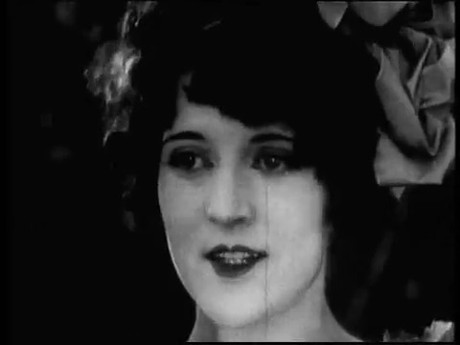
And while we’re at it, let’s look at Oz itself. Semon showed Oz as little more than a castle set. We don’t get a sense of the world beyond, or that it holds any sort of magic. In his story, Oz seems to be less a far-off, magical land, and more the equivalent of Germany. Now of course, much of this could have been due to the limitations of the film that they were making in 1925, but the fact that we spent fully have of the run-time clowning around in Kansas certainly didn’t help. Fleming, on the other hand, really tried to go the distance in creating an Oz that was decidedly different from the world we are watching it from. The colors, the characters the sets all support the notion that we’re not in Kansas anymore.
I think part of what made Victor Fleming’s 1939 film so successful was the fact that it got back to basics and is actually a pretty faithful adaptation of Baum’s first book (which is pretty amazing, considering how many drafts and different writers were brought on board at various points in production). Sure, some details are trimmed here and there, a few plot points seem to be condensed and a few adventures are left out, but overall, it’s pretty much the same story. All of the important pieces are accounted for and the film is set up to be exactly the thing Baum created - an engaging and magical children’s tale.
The thing that struck me the most about Semon’s film, in fact, is just how needless it was to connect it to the Oz property at all. It was clearly a vehicle for the two comedic actors in the lead roles (Semon himself, and Oliver Hardy, who would go on to become half of the famed Laurel & Hardy duo). And while they play their roles well and the film is filled with sight gags, pratt falls and general clowning around that probably played well with 1920s audiences, all of that could have been achieved without making this an Oz film. The first 45 minutes consist of comedic shenanigans on the farm before Oz even really enters the picture.
Once we finally get to Oz, things being to look a little more familiar, but not much. We have the Wizard, Scarecrow, Tin Man and Lion making appearances, but that’s all they really are. Ultimately, this story is really just a battle for the throne (and a sloppy one, at that), and the farmhands just sort of get stuck in the middle. They never take on the actual roles of the Scarecrow, Tin Man and Cowardly Lion as personified in Baum’s story. They just grab the nearest available disguises and act accordingly. They could have been a pumpkin, a butterfly and a toilet, for all the difference it makes to the events at hand. It really just feels like an attempt to make a loose connection to the initial story for the benefit of being able to sell the film based on the Oz name.
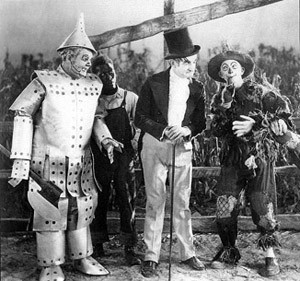
I think the thing that struck me the most in this viewing was that the 1925 film isn’t a terrible film, if you’re into a certain comedic sensibility. If vaudevillian-style physical gags and frivolity are your thing, you will probably have a good time watching this film. It was funny and entertaining and carried the spirit of an age with its particular brand of comedy - comedy that was executed quite effectively by its talented lead actors. It’s not bad at all. But as an Oz film, it’s pretty awful. It seemed that the emphasis when Semon was making his film was more on “How can we make this a comedy?” and less on “How can we tell the story of Dorothy in Oz”? It departs so radically from the source material and creates a story that is barely recognizable within the Oz cannon.
Ultimately, it seems audiences in 1925 felt the same. The film was not terribly well-received, and didn’t even play as many theaters as was initially planned - production ultimately led to the bankruptcy of Chadwick pictures, and many of the theaters that had booked the film never even received prints. Despite his previously successful career in silent film, The Wizard of Oz was a key factor in Semon’s eventual downfall.
Before The Wizard of Oz, Semon had been a successful comedian, working first in vaudeville and numerous silent films before transitioning to a short stint in full-length features. As time went on, his films became more and more extravagant (and thusly, more and more expensive), as no gag was too big or too costly. After his debacle with The Wizard of Oz, he returned to vaudeville, and eventually suffered a nervous breakdown and died in a sanitarium in Los Angeles.
After Semon’s film was released, things were pretty quiet on the Oz film front until Fleming’s entry was released in 1939, not only reinstating the classic elements of Baum’s book, but also going to great lengths to create a spectacle that delighted audiences the world over.
Fleming’s film has become not only so well-loved, but THE version of the story. The Wizard of Oz sort of breaks the mold and defies expectations when it comes to remakes, because the remake (or rather, the second remake) went on to not only be the favorite version of the story, but the ONLY version of the story. Audiences went wild for it and it has cemented its place in film history as one of the undisputed classics. We are so used to remakes that come along and half-ass it, but The Wizard of Oz was one that broke all the rules and created something visionary and lasting. And while sequels, prequels and spin-offs have abounded, the 1939 film itself remains the absolute top-shelf master.
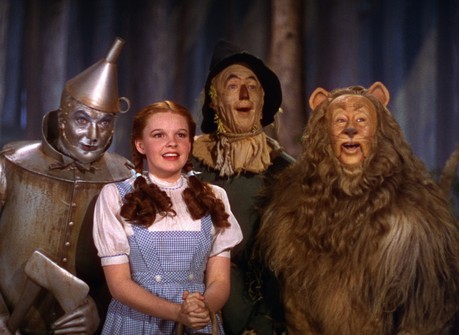
So thanks for reading. I hope you liked it. It was definitely an interesting experience, and I look forward to continuing this colum with all manner of films. If you have any suggestions for upcoming entries, send them my way. I am looking to examine a good mix of both old and new stuff and would love to hear some suggestions!
Follow me on Twitter
